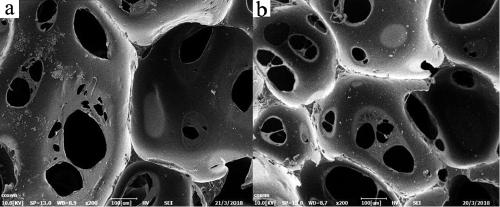Method for preparing flexible polyurethane porous composite material
A technology of porous composite materials and soft polyurethane, which is applied in the field of preparation of soft polyurethane foam materials, can solve problems such as non-special outstanding performance and complicated preparation process, and achieve controllable tensile properties and resilience properties, simple process, Excellent performance and controllable effect
- Summary
- Abstract
- Description
- Claims
- Application Information
AI Technical Summary
Problems solved by technology
Method used
Image
Examples
Embodiment 1
[0040] Add 5g of negative ion powder into a flask with 45g of solvent toluene, ultrasonically disperse for 30min, raise the temperature to 80°C, add 0.75g of silane coupling agent KH550, and reflux and stir for 180min. The reaction liquid was cooled to room temperature, and the solid was obtained by suction filtration, dried in a constant temperature vacuum oven at 70°C, washed three times with absolute ethanol and acetone respectively, dried and ground to obtain the modified negative ion powder additive.
[0041] Take by weighing 60g polyoxypropylene trihydric alcohol (N330), 25g polyoxypropylene glycol (N210), 15g polyneopentyl adipate (PNA-2000), 1.2g modified negative ion powder additive, 1.03g Silicone defoamer DX-02-1, 1.02g of water, 1.0g of triethanolamine (TEOA), 0.16g of stannous octoate (T-9) were mixed together, and stirred at high speed to obtain component A.
[0042] Accurately weigh 45g of liquefied diphenylmethane diisocyanate (MDI) and keep it in a constant te...
Embodiment 2
[0047] Add 5g of negative ion powder into a flask with 45g of solvent toluene, ultrasonically disperse for 30min, raise the temperature to 90°C, add 1.0g of silane coupling agent KH560, and react under reflux for 120min. The reaction liquid was cooled to room temperature, and the solid was obtained by suction filtration, dried in a constant temperature vacuum oven at 70°C, washed three times with absolute ethanol and acetone respectively, dried and ground to obtain the modified negative ion powder additive.
[0048] Take by weighing 75g polyoxypropylene glycol (N220), 10g polyoxypropylene glycol (N210), 15g polyneopentyl adipate (PNA-2000), 2.4g modified negative ion powder additive, 1.03g Anti-sticking and slipping agent Silok-3300, 1.23g water and 0.05g bis(dimethylaminoethyl) ether (A-1), 0.6g triethanolamine (TEOA), 0.14g stannous octoate (T-9) mixed, Stir at high speed to obtain component A evenly.
[0049] Accurately weigh 42.75 g of liquefied diphenylmethane diisocyana...
Embodiment 3
[0056] Add 5g of negative ion powder into a flask with 45g of solvent toluene, ultrasonically disperse for 30min, raise the temperature to 60°C, add 0.5g of silane coupling agent KH570, and reflux and stir for 210min. The reaction liquid was cooled to room temperature, and the solid was obtained by suction filtration, dried in a constant temperature vacuum oven at 70°C, washed three times with absolute ethanol and acetone respectively, dried and ground to obtain the modified negative ion powder additive.
[0057] Weigh 45g polytetrahydrofuran ether glycol (PTMG-2000), 45g polyoxypropylene glycol (N220), 10g polyester polyol (PNA-1000), 1.2g modified negative ion powder additive, 1.08g silicone oil L- 580, 1.6g of water, 0.67g of triethanolamine (TEOA), and 0.25g of dibutyltin dilaurate (DBTDL) were mixed, and stirred at a high speed to obtain component A.
[0058] Accurately weigh 40g of MDI-50 and keep it in a constant temperature state in an oven at 25°C as component B.
[...
PUM
 Login to view more
Login to view more Abstract
Description
Claims
Application Information
 Login to view more
Login to view more - R&D Engineer
- R&D Manager
- IP Professional
- Industry Leading Data Capabilities
- Powerful AI technology
- Patent DNA Extraction
Browse by: Latest US Patents, China's latest patents, Technical Efficacy Thesaurus, Application Domain, Technology Topic.
© 2024 PatSnap. All rights reserved.Legal|Privacy policy|Modern Slavery Act Transparency Statement|Sitemap


